Last Updated on: 20th October 2023, 07:32 pm
Completing the Everest Base Camp trek in May 2022 was the highlight of my year and the first major trip after the pandemic.
I had been planning my journey for 6-7 months. This allowed me to hunt for mountain gear bargains and to train for EBC Trek to get back in shape after two years of not moving that much.
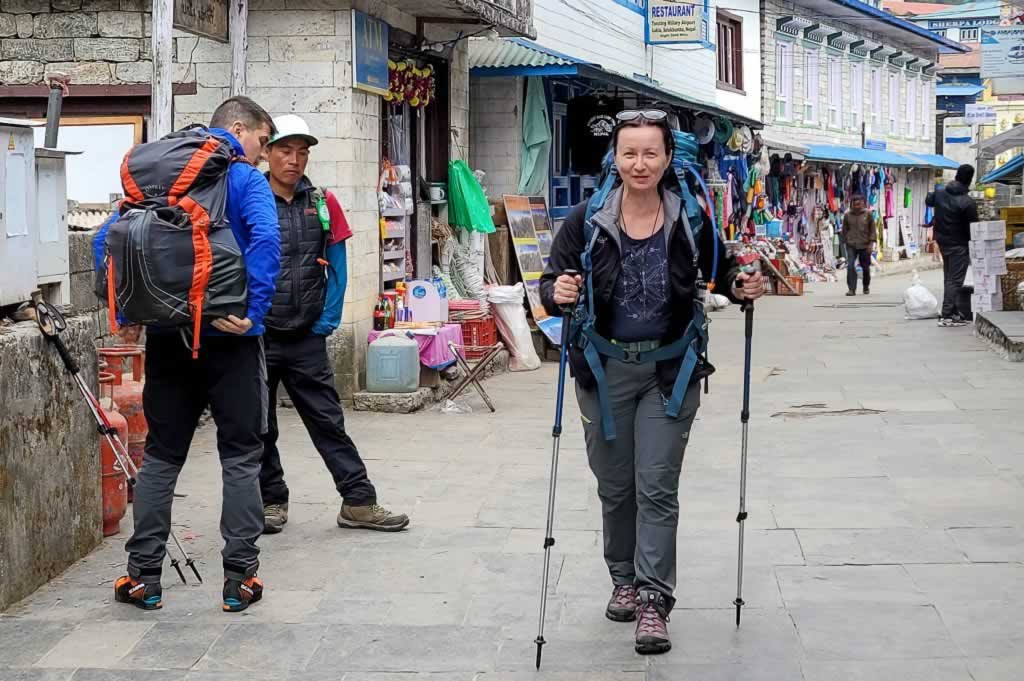
This is the first article in a series aiming to provide you with first-hand information on EBC, one of the most popular and busiest treks in Nepal.
You’ll learn how hard the trek to EBC is, how long it takes, how much it costs, when is the best time to go to Everest Base Camp, how to prepare for it, and what to expect from this memorable journey. I’m still wading through my thousands of photos and hours of video footage to pick the best ones for this guide. It feels as if I’m taking the same trip again, this time without having to put up with the cold, sleepless, and sometimes breathless nights.
Here’s a list of the most frequently asked questions about the Everest Base Camp trek. Next, I’ll cover the journey, day by day, with facts, figures and recommendations. If you’re looking for packing tips for Everest Base Camp Trek, click on the previous link to read that article.
Here are also some of the best hiking tips for women you could use in your adventures. It’s always a good idea to show up fully prepared and ready to overcome any obstacle.
Main Topics of Everest Base Camp Trek FAQ
- Is Trekking to Everest Base Camp Worth It?
- How Hard Is the Trek to Everest Base Camp?
- Can a Beginner Do the Everest Base Camp Trek?
- How Long Is Everest Base Camp Walk?
- What Is the Best Time of Year To Do the Everest Base Camp Trek?
- Are Glaciers Slippery?
- What Are the Tea Houses Like in Nepal?
- How Is Food on EBC Trek?
- Best Money Exchange to NPR on the EBC Trek?
- Welcome to WISE, the Smart Way of Paying in Nepal
- Can I Do Everest Base Camp Trek Alone?
- How Much Money Do I Need for Everest Base Camp Trek?
Is Trekking to Everest Base Camp Worth It?
If I were to share with you the main teaching of this adventure, it would be a quote from Carlos Castaneda’s book, Journey to Ixtlan:
“We hardly ever realize that we can cut anything out of our lives, anytime, in the blink of an eye.â€
What are the things you think you can’t live without? If you’re like most of us, you must have a list of such items you can’t imagine cutting out of your life. The EBC trek is a good opportunity to put your list to test. It can improve your decision-making ability in all areas of your life.
This trek isn’t about strength or skill, but rather about flexibility and mindset. It isn’t about success, but about giving in. It is about cutting out things we take for granted such as internet, washing water, fresh fruit and veggies, and even oxygen.
Trekking to Everest Base Camp teaches you to welcome uncertainty and discipline into your life. It teaches you to listen to your body, to acknowledge its pet peeves, and to keep walking, anyway.
It’s worth saying here that you’d better make sure you don’t show up to the game unprepared. Physical training can make the difference between bliss and misery. If you need motivation to exercise everyday, training for the EBC trek will do.
Another reason why you may find the EBC trek rewarding is that people would look up to you in awe once you’ll have completed your trip. Everest is a symbol that inspires respect. Associate yourself with this icon and you’ll enjoy a bit of this respect, as well.
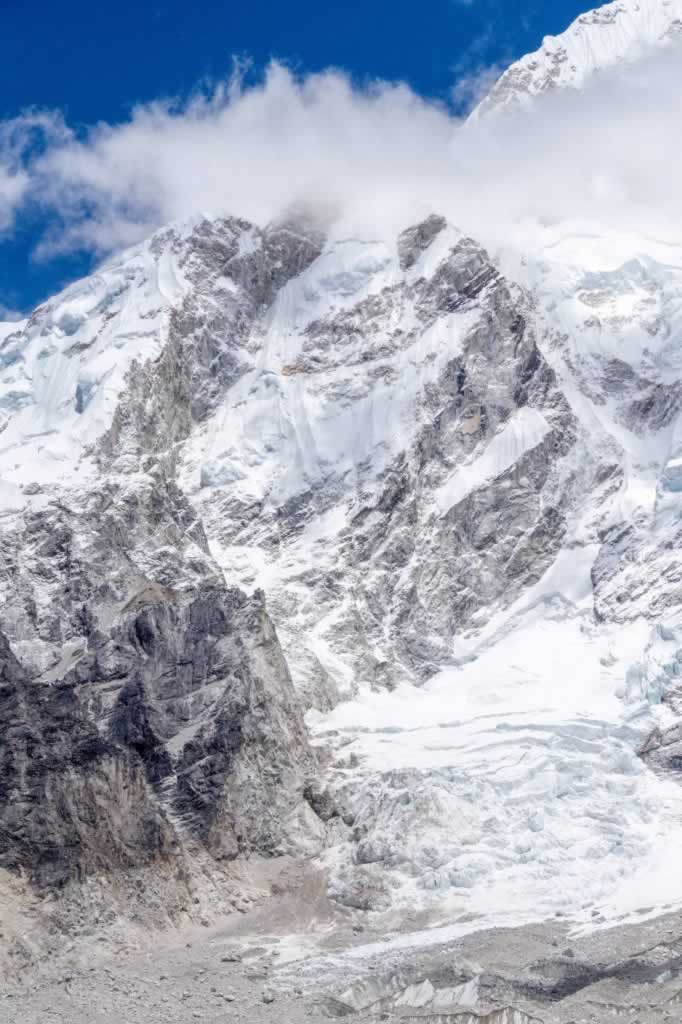
Not the Everest, but this doesn’t make it less beautiful
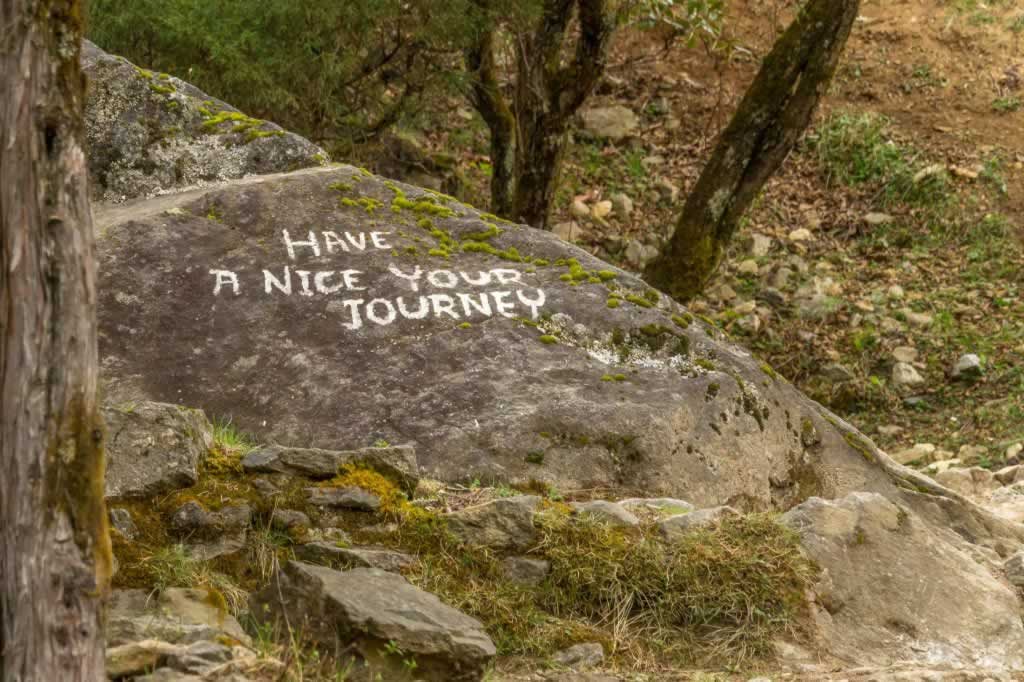
Indeed!
Also, the wonderful landscapes featuring some of the world’s highest mountains, scenic rhododendrons, majestic shrines, rivers, glaciers, pine forests, and glacial lakes make trekking to the base camp worth it. They are well-worth carrying your camera, too (even though a phone with a good camera would do just fine).
How Hard Is the Trek to Everest Base Camp?
Without being technically challenging, the Everest Base Camp trek is a tough and long walk at altitudes between 2700m and 5400m. Your comfort will partially depend on your budget, but there will be lots of things beyond of your control. Even if you book luxury lodges (wherever available), you’ll still need to wake up and pack early in the morning, to carry your day pack, and to put up with the effects of high altitude.
Above 3500m, most activities we usually take for granted become an effort. Even bending over to tie your shoelaces will require a few moments to catch your breath afterwards. The daily 6-9 hours of walking on uneven terrain will also take a toll on your stamina.
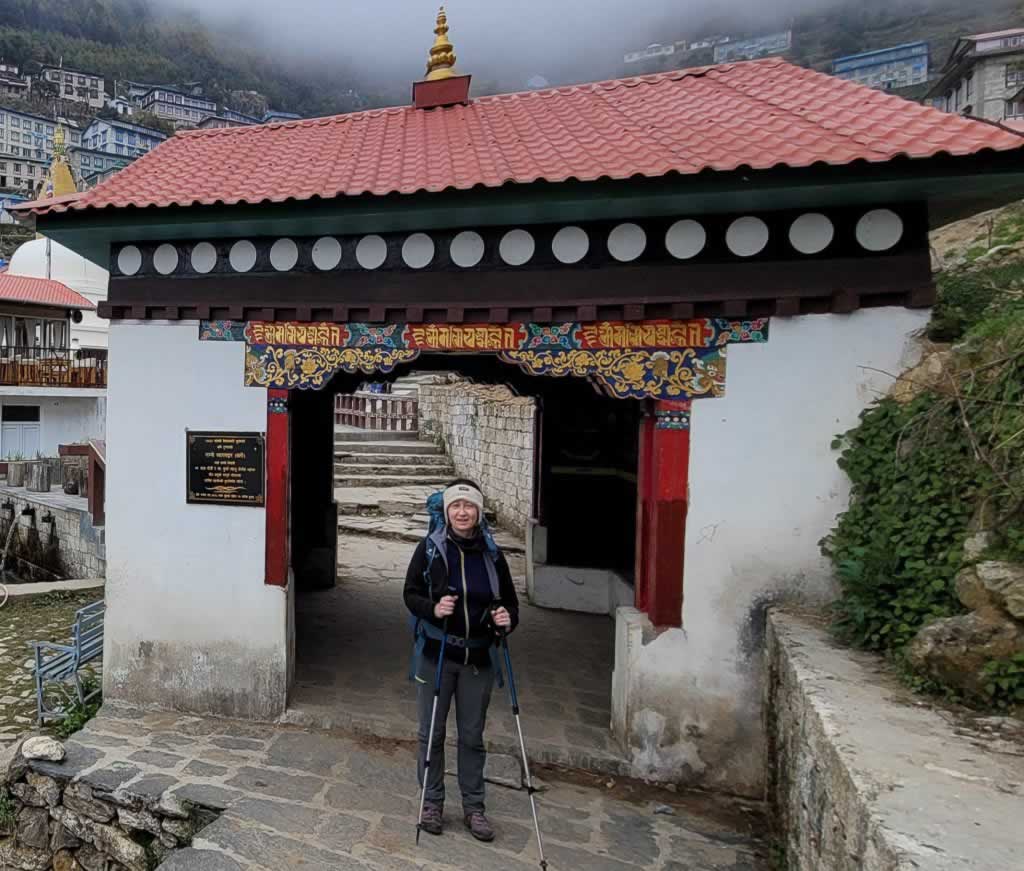
In the above photo, I’m still alive and smiling, at the gate of Namche Bazaar (3440m / 11,286 ft), after a seemingly endless, steep ascent.
As you leave Namche Bazaar and you cross the 4000m altitude threshold, chances are you’ll experience some sleepless nights. Oftentimes you’ll go to bed and fall asleep right after dinner, only to wake up around midnight, gasping for air. Nights are cold, tea house rooms aren’t heated, so your body will try hard to keep you safe by producing unbelievable amounts of snot. That stuff dries inside your nose and hurts the sensitive nasal lining, driving you crazy. Blowing your nose will be painful and you’ll want to blow your nose a lot to clear the airways.
Even if you only get mild altitude sickness symptoms, you’ll have to put up with all of the above. Imagine how you’d feel in the event of developing more severe Acute Mountain Sickness (AMS) symptoms.
From technical point of view, I’d consider the Everest Base Camp trek of medium difficulty. There’s no climbing involved, but the path goes up and down quite a lot, so you should expect to get tired. Sometimes, there’s no visible trail, but only a messy pile of boulders, calling for intense focus to find the best ones to step on.
Even though I suffer from a crazy fear of heights, I’ve only had minor (and sometimes hilarious) hiccups in Cho La Pass and on the glaciers (jumping on unstable boulders is not my cup of tea, that’s for sure).
The suspension bridges are way less scary than they appear. Hint: I found out that wearing my sunglasses while crossing suspension bridges helped me feel less dizzy. Filming while crossing also works, because it makes you focus on your camera rather than the surroundings.
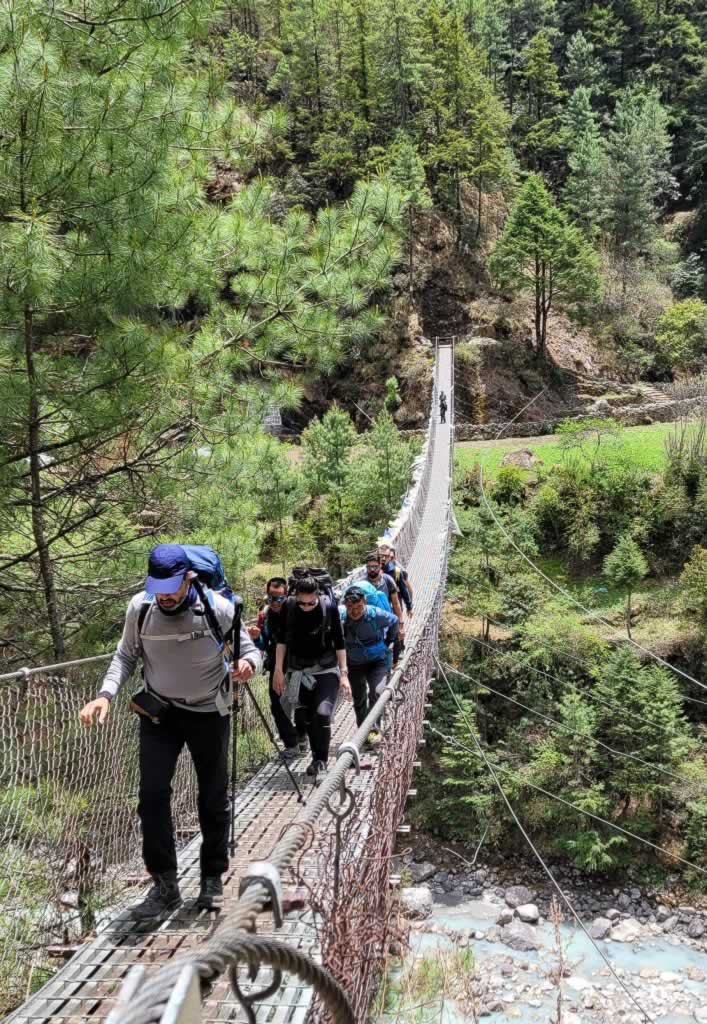
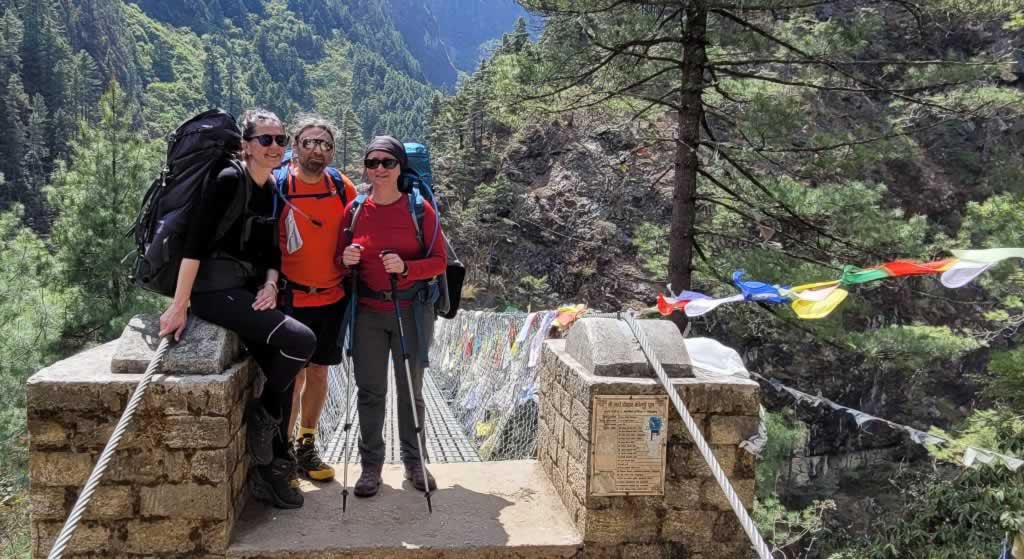
After passing the 10th bridge, I couldn’t even be bothered to bend my knees or close my eyes while crossing. I’m now the uncrowned queen of Nepalese suspension bridges, so you know!
Can a Beginner Do the Everest Base Camp Trek?
Absolutely. However, the difficulty level depends on how fit the beginner is. Walking for long hours in oxygen-deprived environment is strenuous. Walking 130km in 12 days is a tough nut to crack (and this is the standard and shortest round trip route). If you can’t cope with that, you’ll miss all the fun, as you’ll have to work harder than everyone else on the trail.
If you don’t want to suffer on the mountain, you’d better train for a few months prior to your trip. The training can be any cardio workout you enjoy, be it running, swimming, or even brisk walking. Climbing stairs is one of the best things you can do to prepare for the hike.
Also, if this will be your first time hiking, consider hiring a guide or joining an organized group. Learn what gear to take with you, how to choose your backpack, how to pack, and how to behave on the mountain.
According to Adventure.com, the success rate of Everest Base Camp trek is 90 percent. The same source mentions, though, that eight people died on the EBC trek during the 2018-2019 season. I’ve read other statistics that say the EBC trek success rate is only 65%.
Anyway, you’ll want to show up in your best possible shape, in order to enjoy your time on the mountains. I’ll share my thoughts and my EBC trek training protocols in a future article.
How Long Is Everest Base Camp Walk?
The standard EBC trek route is 65km long. It starts from Lukla and it passes through Phakding, Monjo, Namche Bazaar, Tengboche, Dingboche, Lobuche and Gorakshep. Taking the same route back (or the Pheriche variant to Dingboche and Tengboche) adds up to a total of 130km of walking. Add 5-10 more kilometers you’ll climb on the acclimatization days in Namche Bazaar and Dingboche. You’ll need in total 12 days: 9 days to climb to EBC and 3 days to descend back to Lukla. My future articles in the Everest Base Camp Trek series will share facts and photos from the trail, to help you plan your own trip.
The return via Chola Pass, Gokyo, Dole and Namche Bazaar is longer, harder and more time-consuming. You’ll need a minimum of 15 days: 9 days for the ascent and 6 days for the descent (with sleeps in Dzongla, Dragnak, Gokyo, Dole, Namche Bazaar and Lukla). Bear in mind that the flights from Lukla to Kathmandu depend on the weather conditions. You may find yourself stranded in Lukla for one or more days, so take this into account when you book your flight home from Kathmandu. If you can’t afford to wait for better weather but you can spare a couple hundred dollars, there’s always the helicopter alternative.
What Is the Best Time of Year To Do the Everest Base Camp Trek?
There are two main seasons, one between February and May (before the monsoon) and another one starting late-September and going until December. The best time to go to EBC depends on your resilience to cold. Apparently, the colder periods are also the ones with the clearest skies, so you stand better chances to have perfect views of the Everest, Lhotse, Nuptse, Ama Dablam, etc. Closer to the monsoon period temperatures don’t drop below the freezing point, but the risk of rain and clouds is higher.
I did the trek between May 1st and May 16th, together with three friends, one porter and one guide. We already had our tickets to fly out from Lukla to Kathmandu for May 18th and we couldn’t have them changed, so we spent two nights in Lukla, instead of one.
We had good weather overall, with only one day of walking in rain. Nonetheless, we didn’t get to view a cloudless panorama of all those mountains for the most part of our trek.
I took the photos below on May 16th, the last day of the trek. You can easily see that the monsoon was just around the corner.
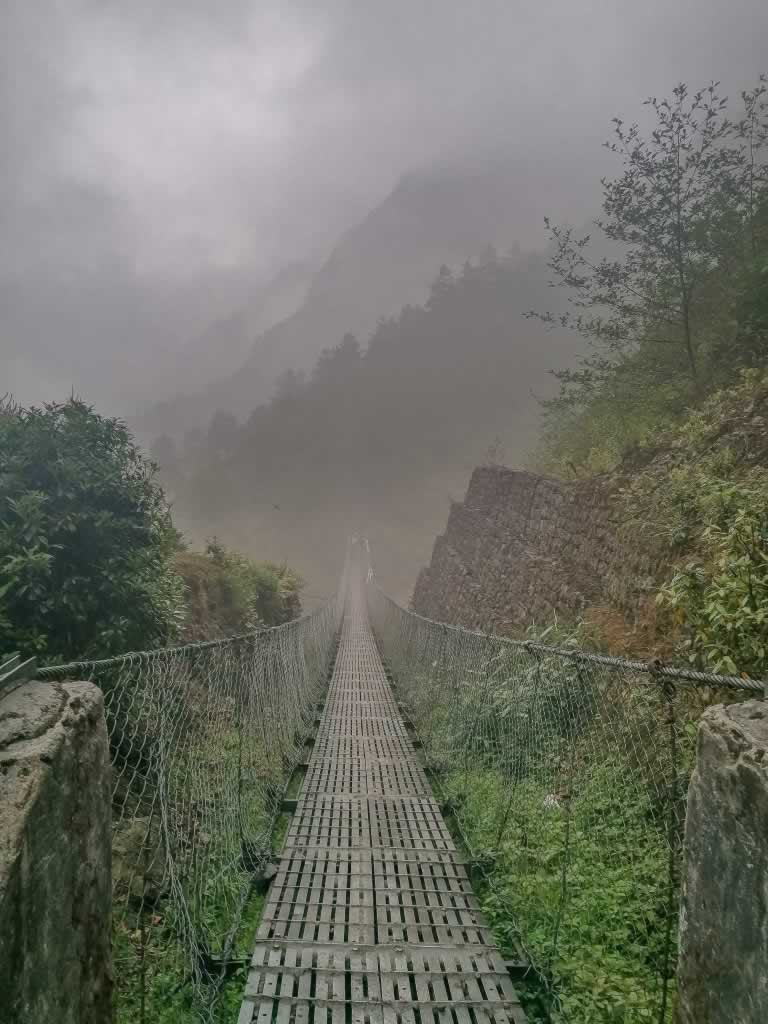
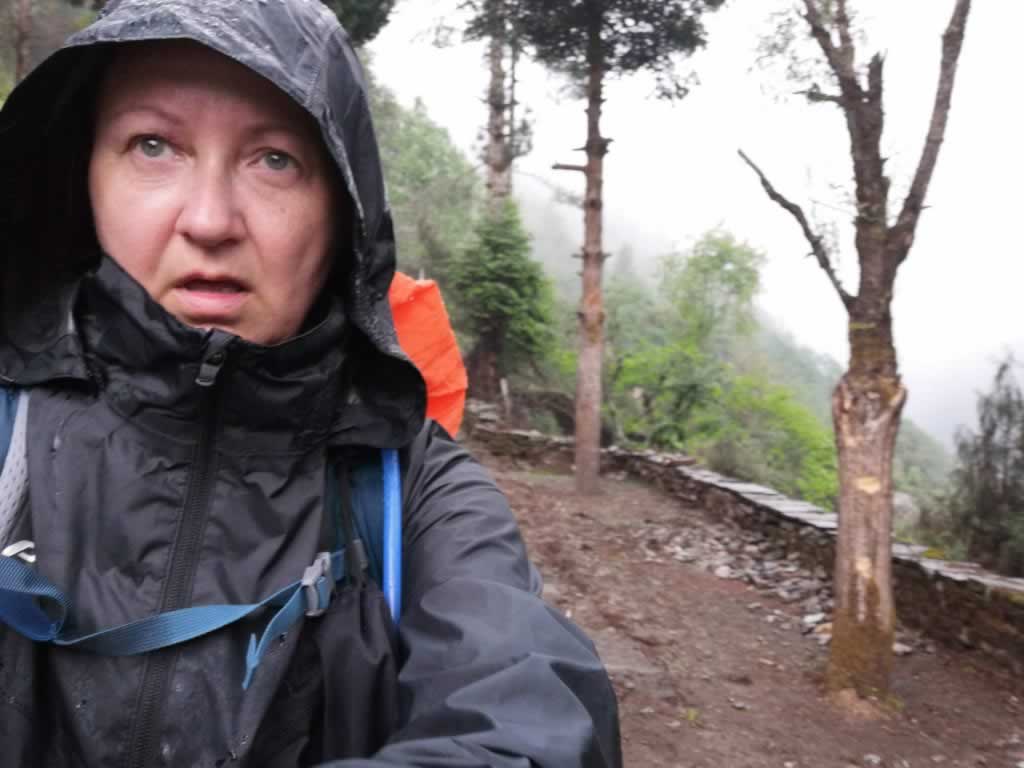
This was the only day when I got to wear my rain gear (fortunately)
After 14 days of walking, the couple of hours we had to put up with the rain were nothing but a piece of cake.
Are Glaciers Slippery?
When you think about glaciers, you may picture beautiful, translucent ice, something like a natural, huge skating rink.
You’d be wrong, as so was I. Glaciers are made of ice at their core, but the outer shell is a pile of rubble and rocks. Besides, the moraines (the margins of the glacier) are nothing but piles of debris, rocks crammed on top of boulders, pebbles, dust and the odd ice surface here and there.
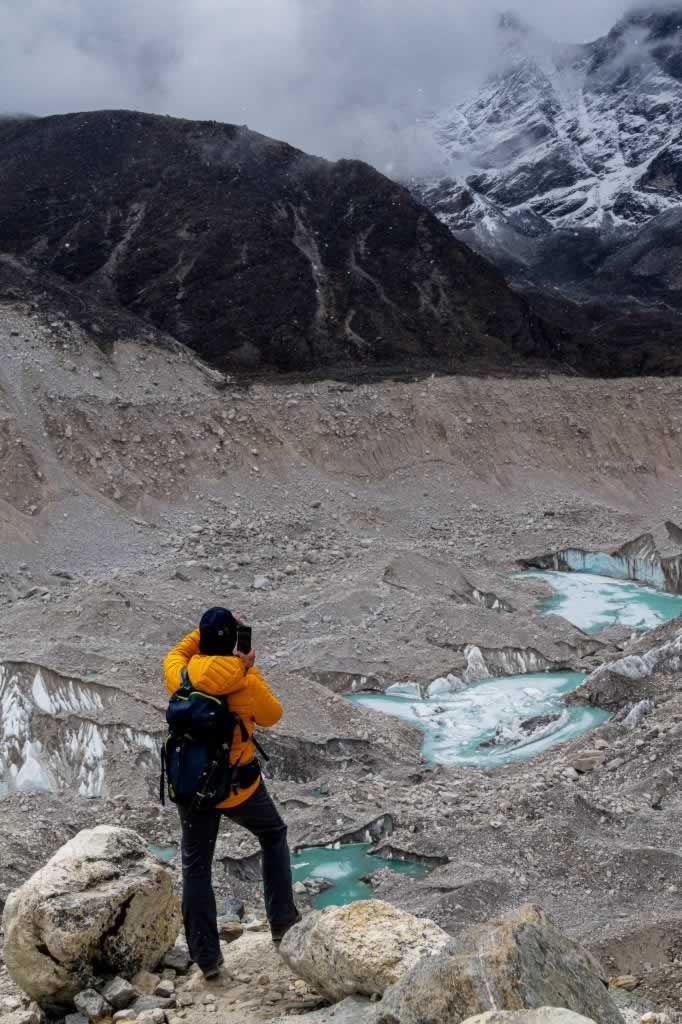
This is Khumbu, the glacier the Everest Base Camp sits on
What Are the Tea Houses Like in Nepal?
Tea houses are similar to mountain lodges in Europe. They have a large dining room, shared toilets, and many private rooms. Most private rooms are double.
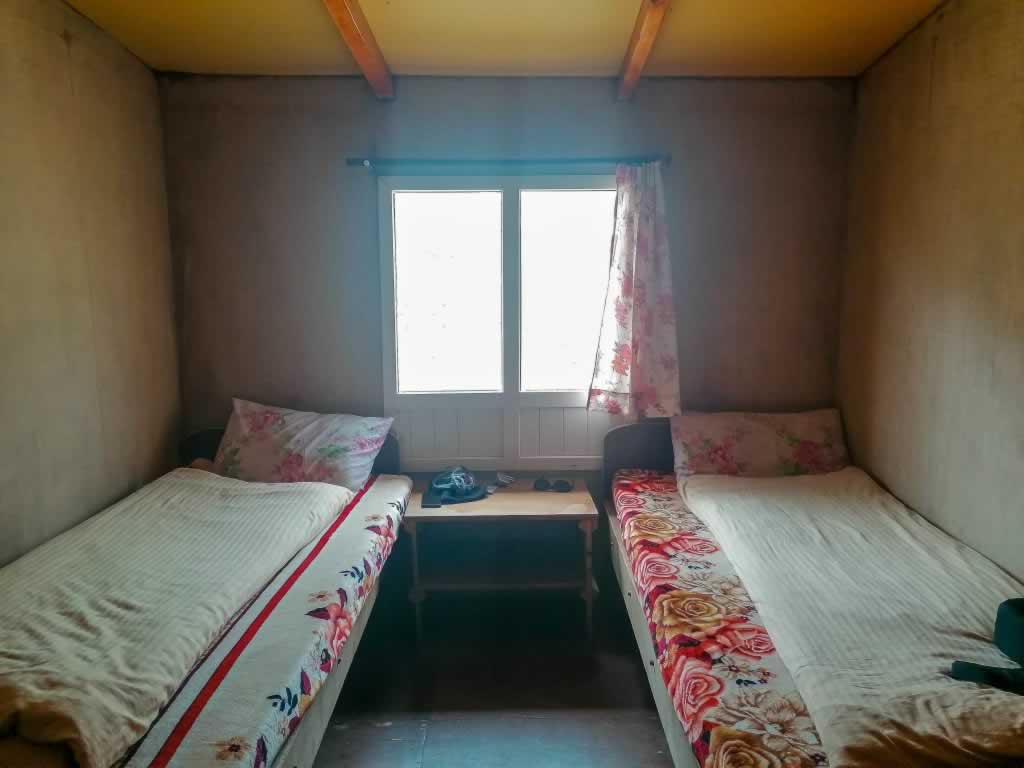
They are basic: two single beds with linen and a duvet, separated by a small table. Above this table there’s a window. There are a few clothes hangers on the wall or on the door.
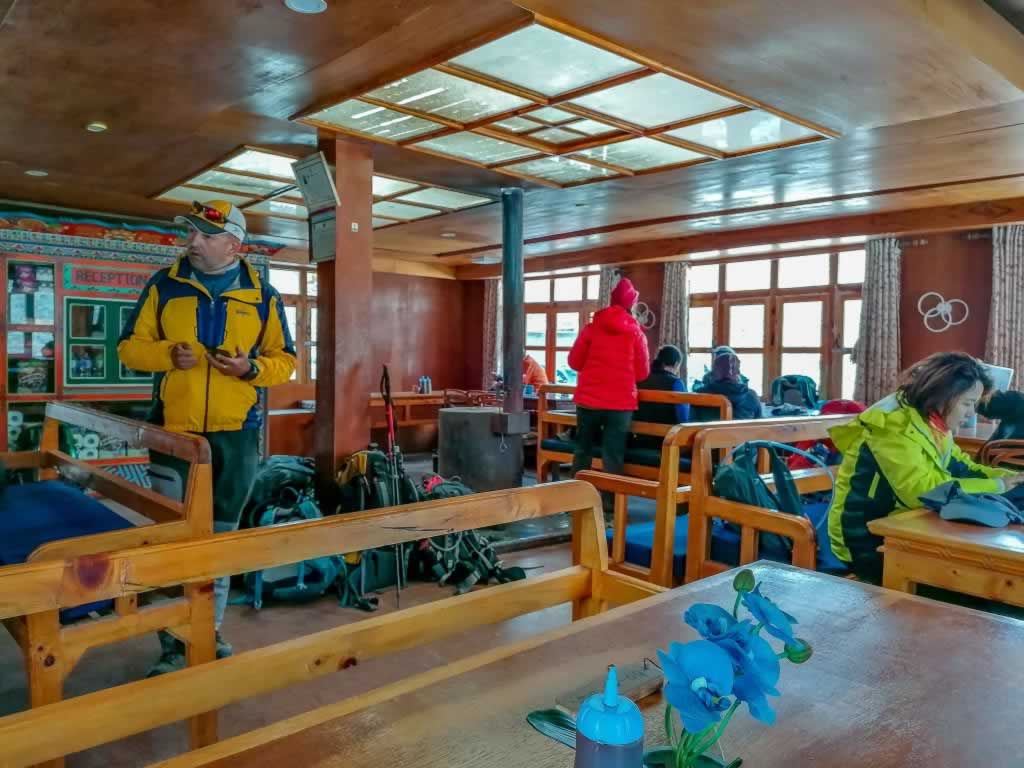
The only heated space is the dining room, with its stove that works with yak dung. The effectiveness range of these stoves is rather limited, so you’ll want to take care when choosing your seat in the dining room.
In most tea houses, as well as along the trail, you’ll find both squat type and bowl toilets. Most of them are sparkling clean. We found that pretty impressive, taking into consideration that many of these places lack running water.
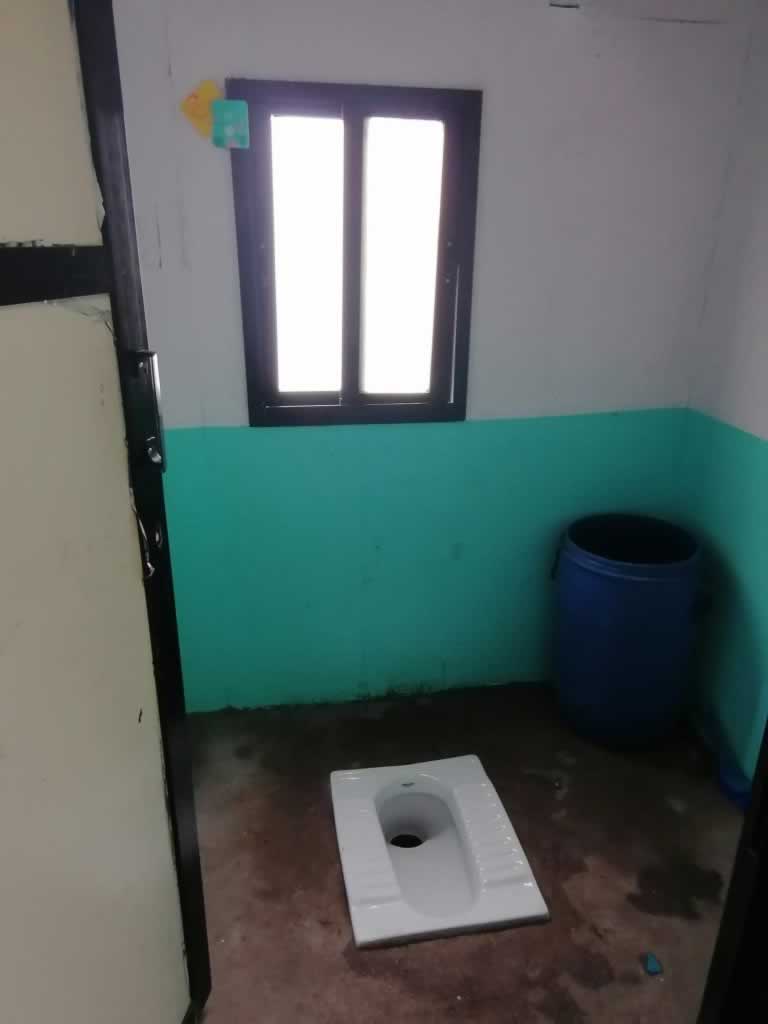
From Lukla to Jorsalle, you’ll find lots of public toilets in the villages you’re going to cross. After Jorsalle, you won’t find any toilet until Namche Bazaar. The higher you get, the more you’ll need to use the so-called “long toilet” as our guide, Santa, used to tell us.
There’s no hotel booking site to help you find a tea house room in all of the villages on the EBC Trek. However, if you hire a guide, you won’t have to bother with bookings.
How Is Food on EBC Trek?
By comparison to mountain huts in Europe, I’d say tea houses on the EBC trek offer a wider variety of food choices. You’ll find garlic soups, noodle soups, pasta, potatoes, momos (dumplings with various fillings), omelets, and the ubiquitous Dal Bhat, a traditional Nepalese dish consisting from rice, lentils, curry, and one piece of chapati or another type of flatbread. If you want to see photos and to read more about these dishes, check out my Everest Base Camp Trek food guide.
Dal Bhat was by far my favorite. I probably ate it on at least six evenings. It was tasty and filling, and you could ask for a rice and lentil refill. Dal Bhat is also the food choice of porters and guides. They even use to say “Dal Bhat power, six hour!”
Best Money Exchange to NPR on the EBC Trek?
I had some US dollars that I exchanged in Kathmandu, thinking the amount was going to be enough for the entire trek. You can’t imagine how I was wrong! I had to exchange money and to use ATM machines multiples times. Most of the tea houses along the trek require cash payments. While they claim to accept VISA and Mastercard cards, their machines can’t work without an internet connection (and that’s scarce at such high altitudes). I managed to use a credit card only once and I was charged an extra 5% fee for that, plus the currency exchange commission.
Welcome to WISE, the Smart Way of Paying in Nepal
One of the best things you can do before you embark on your Everest Base Camp trek adventure is to get a Wise account with debit card. Wise is a financial service that allows you to hold 50 currencies in one single account. It enables you to spend your money abroad without hidden fees. Sending money with Wise is cheaper than old-school banks.
I already had my Wise account, so I made sure I loaded it with dollars. Then I opened a NPR account and exchanged my dollars at a very good rate, much better than bank rates. I withdrew NPR from ATM machines in Kathmandu and Namche Bazaar using my Wise debit card. Click here to see if you are eligible for a Wise account and to get it right away.
Can I Do Everest Base Camp Trek Alone?
Trekking solo requires you to know very well what you’re doing. If you’re an experienced trekker, fit, and wearing the right gear, there’s no reason why you couldn’t do the Everest Base Camp Trek alone. If, on the contrary, you aren’t familiar with hiking, trekking or mountaineering, you shouldn’t trek alone on the EBC or on any other trail for that matter.
The EBC trek is a very busy one. This could make you think that missing the trail is impossible. Yet, there aren’t clear markings at all crossroads, so it’s very easy to take a wrong turn, particularly when you try to avoid the crowds. Not hiring a guide might cost you dearly. Besides, you’d miss all those funny moments on the trail, all those conversations with your guide, and all the help a group can provide you. Also, you’d have to make your arrangements for accommodation by yourself. After many hours of trekking, the last thing you’d want is to go from lodge to lodge, trying to find a bed for the night. Most rooms in tea houses are double, so you may end up sharing yours with someone else.
These being said, accommodation availability depends on the time of year you do the trek. After mid-May you’d find plenty of rooms, as the season would be almost over. March and April, on the contrary, are very busy. Bear in mind that in Tengboche and in Gorak Shep the supply is very limited, so you’d better try to book your room in advance.
The lodges on the EBC trek provide shelter and food. You are expected to have dinner and breakfast at the lodge where you sleep. There are no waiters to take your order and to bring you food and drinks. Guides act as waiters for their groups. They take your orders, pass them to the kitchen staff, bring you the food and the drinks, and collect the money to pay to the lodge.
Guides call the lodges to book rooms for you in advance. Porters take your duffel bag and put it in your room, so that you can find it on arrival. If you’ve never hiked for many days in a row before, you may not realize the inestimable value of being able to simply crash on a bed without any other worry than taking off your shoes and your socks.
Our first intention was to do the trek without hiring anyone. I’m so glad we’ve changed our minds! The guys from Actual Adventure, the agency we had booked our domestic flights with, went out of their way to welcome and to support us in everything. They sent a team to pick us up from the Tribhuvan International Airport, they helped us sort out the first night in Kathmandu and the Kathmandu-Lukla flight, and they provided an awesome porter-guide team.
How Much Money Do I Need for Everest Base Camp Trek?
The cost of doing the EBC Trek depends on how you choose to do it. Do you want to join an organized group? Do you want to hire a porter or a guide? Do you want to helicopter yourself out of Gorak Shep? Do you want to use water purifying tablets or bottles, or you’d rather buy bottled water along the way? Are you fine with shared toilets? There are rooms with en-suite bathrooms, but they are more expensive. There are also luxury lodges (which I saw only from afar, so I can’t tell you how they are).
I’ve published a breakdown of my expenses in this Everest Base Camp Trek Cost article. My rough estimate is a minimum of $25 US per day on average for food and lodging, plus the visa fee ($50 for one month) and the two trekking permits (about $50 in total). The porter is $20 per day and the guide is $25 per day (plus tips). You’ll split the cost between your group.
The Kathmandu-Lukla-Kathmandu flight costs around $320 US. Our Turkish Airlines international flight Bucharest-Kathmandu-Bucharest was about $720 US.
Accommodation in Kathmandu starts from a few dollars a night. Our hotel in Thamel, Kantipur Temple House, cost $55 US per night for a double room. Kantipur Temple House is a very comfortable and beautiful hotel. I highly recommend it. There’s no need for breakfast, as you’ll find nice restaurants and cafes near the hotel. Our favorite was Chikusa Cafe, a place with excellent coffee and tea, tasty breakfast, and very good service.
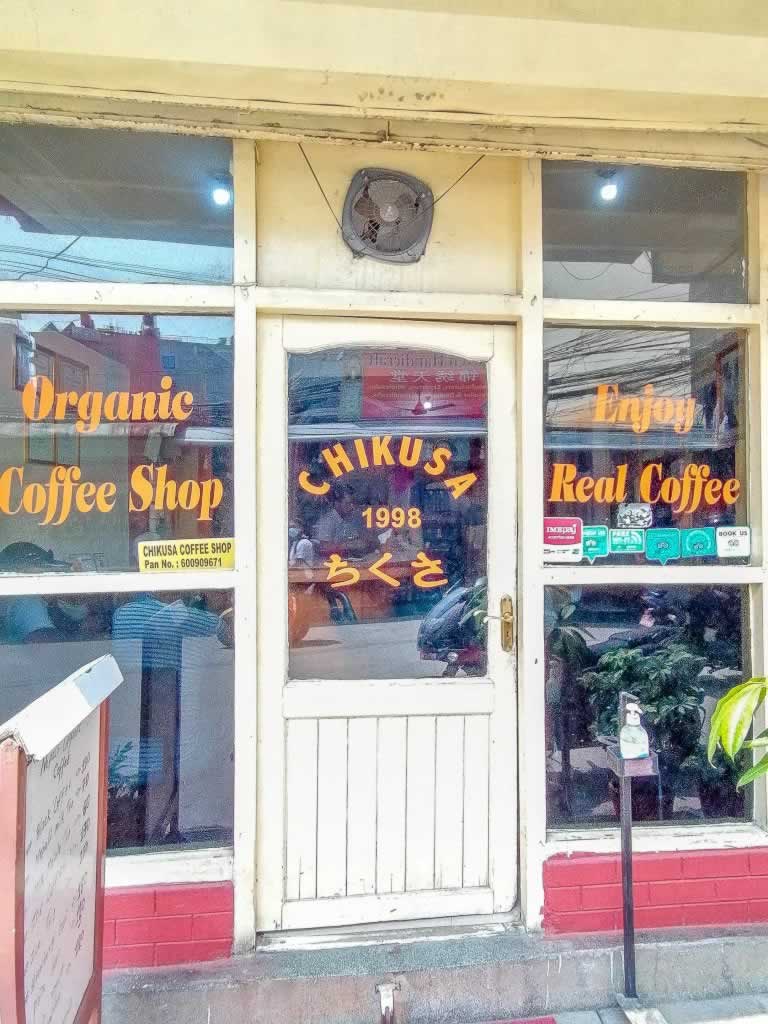
More money-related details are soon to follow.
- Dingli Cliffs: How To Visit Malta’s Highest Point - April 24, 2024
- Blue Grotto Malta - April 23, 2024
- Ramla Beach Gozo, Maybe the Best in Malta - April 9, 2024

